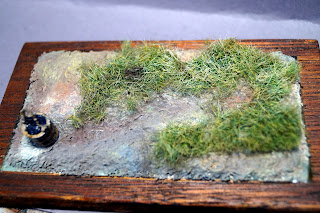As from now I will try to write my blog in English again. I joined several international modelling groups on internet and this way they can follow my blog more easier.
I'm currently working on several figures of the 80-years war. The NSM ( Dutch Society for Modelfigures https://www.modelfiguren.nl/) made several beautiful figures about this period and I bought some of them. But most figures I make are conversions.
This little vignette represents two engineers working around 's Hertogenbosch during the siege of the town.
I made these figures almost from scratch.
The main parts are from Airfix Collector series and besides that I used Magic Sculpt and Green Stuff.
First I started with the sitting engineer.
There is an illustration of an engineer in the book of Bouke the Groot (Osprey: Eighty years war) which I used as an inspiration source.
The upper torso is made from the torso of the Airfix pikeman or musketeer. The legs are from a Tamya figure of a seating officer.
Cut off the boots and replace them with the boots of the English Cavalier. Head is from the Airfix musketeer.
New (fluffy) trousers are made of Magic Sculpt and the boots are made with Green Stuff.
The engineer is holding a wooden board on which I glued a piece of thin paper. You have to look in your spares-box for the right arms. I cut off the left hand and put it in the right holding position. Use thin wire to attach the hand in the right way to the arm. Then finish off with Magic Sculpt.
The large sash is made of Magic Sculpt.
Before I start painting , the hole figure is covered with PVA glue. I put a thin layer over the entire figure. This way little gaps etc. are filled in, also the gap between the belts and the torse. After drying I spray an undercoat of grey primer on the figure.
Face is painted in oils and the rest in acrylics.
After painting the basic layer I use Citadel Contrast for shading. It's like painting with watercolours and you have to practice a lot on cheap figures to get the knack of it. But the result is very satisfying. It gives your figures more depth of colour.
I started with the underground after completing the first figure. Base is made from the lid of a jam jar. Then the bank of sand is build up with Das self hardening clay. After painting the base colour ( Grave yard earth from Citadel ) I use several colours of pastels to give it an earthy dry look.
Now on with the second chap of this project!
It had to be a standing engineer next to the writing person.
Therefore I had to use the legs of the French curassier, because I needed the boots.
The legs are cut and re-positioned on several places in order to get a standing person.
Then the wide trousers are made with Magic Sculpt. Upper part of the boots are made with Green Stuff.
Uper torso is from the English Cavalier. The arms are perfect to use as you can see.
The head is a metal one from one of the figures of the NSM . I added a mall beard from Magic Sculpt(MS) .Hair is also done in MS.
Leather coat below the waist is made of Green Stuff. Sash with MS
Figure after painting
After finishing a paint job I let the figure dry overnight. Then I give it a coat of very matt varnish and with matte I mean really matte
I think there is only one kind of varnish which can do the job.
It's originally used by art painters but I never found a better product than this.
This is the result. A nice little dio with bright colours. It'll give a nice touch of colour among the blue and green uniforms.
O, and the telescope the standing man is holding....
It's made of a gun shell 1/48 from an old Bandai Flak.
Never trow away anything. You might need it in future 😄

















































